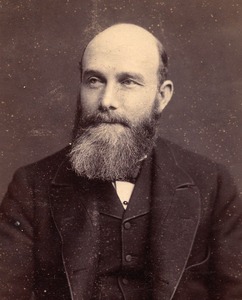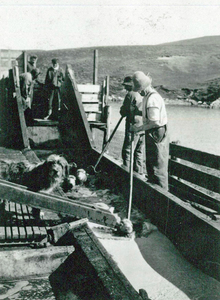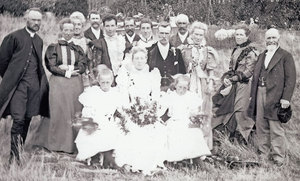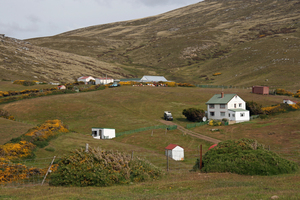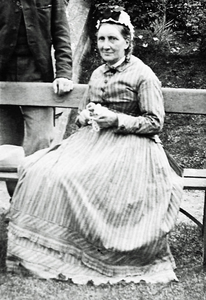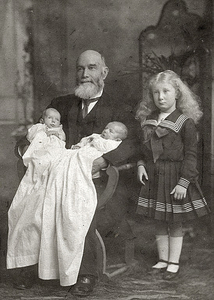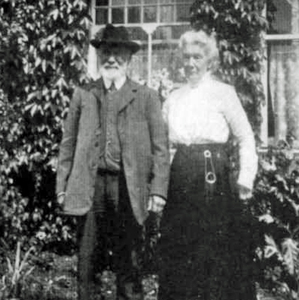BERTRAND, WILLIAM WICKHAM
1837 - 1914 from Dominica (also England)
farmer, was baptized in Dominica (British West Indies) on 21 December 1837, the sixth of seven children of Edmund Rufus Bertrand and Frances Elizabeth Bertrand, née Lee. His father was a planter and their home Tabery Estate.
Bertrand was educated in England under the care of his uncle Godfrey Bolle Lee, subsequently travelling in India and Australia.
Bertrand learned sheep farming on the estates of his Lee cousin in the Canterbury district in New Zealand and by 1867 was working alongside Ernest HOLMESTED on Matson Station. Together the two men set sail on the Paria for Valparaiso where they arrived in August of that year. They crossed the Andes by mule and on foot, 'crossing the saddle of the Cordillera called Portillo Pass'. When they arrived at Mendoza eleven days later they met John Switzer who was to come with them to the Falklands. They survived a series of hair-raising adventures - Argentina was in the throes of a revolution at this time, with an outbreak of cholera to complicate matters.
Bertrand and Switzer went to Uruguay where an agent for Smith Bros was prepared to sell their Crown lease on New Island which still had twelve years to run, and this they acquired. There were about four thousand sheep on the island at this time and later these would be used to stock Adelaide Station.
Bertrand and Switzer went to the Falklands before committing themselves to anything, and then Bertrand returned to Buenos Aires to collect Holmested; he and Switzer having already acquired from the Colonial Government a licence to occupy Shallow Bay Estate. This was to be called Adelaide Station and included the farms later known as Hill Cove and Roy Cove.
Bertrand and Holmested landed in Stanley in July 1868, the latter going to Shallow Bay with Switzer. Bertrand, to help with funds, took a job with the Falkland Islands Company at Darwin.
He introduced tobacco as an insecticide to be used in the newly-constructed 30ft plunge dip, which method he had used in New Zealand in an effort to eradicate scab in the flocks. Bertrand built a new shearing shed at Darwin: ' a perfect triumph of ingenuity, where the sheep are penned and sheared, and the wool baled, pressed and stowed for shipment all under one roof'.
He introduced the slatted tables for rolling fleeces as are in use today, and was also instructed to start scientific breeding to improve the quality of the wool. He was described as being 'evidently a man of business, a sharp decided character, giving the impression that he would stand very little nonsense'.
Bertrand had by now met his future wife, Catherine Felton, and they were married in September 1868 at Trinity Church, Stanley. They had ten children, Edith Martha (b1869), Maud Alice (b1871), Elinor Frances (b1873), James Godfrey Wickham (b1875, the father of Cecil BERTRAND), Mabel Kate (b1877), Constance Madeleine (b1878), Nora Annie (b1881), Herbert William Roy, and lastly twin girls born in 1887, Lillian Ella Gladys and Kathleen Maud Phillis.
In November 1870 Bertrand arrived at Shallow Bay, his contract with the Falkland Islands Company at an end, and shortly after his wife and baby Edith followed him. Switzer had gone back to New Zealand to face a charge of arson, so it was just Holmested and Bertrand who continued in rough and very hard conditions. Maud was born at Shallow Bay in 1871 and baptized there by Thomas BRIDGES.
At this stage a marked tension was growing between Holmested and Bertrand, and when Holmested returned from leave in England in early 1872 they decided to divide the estate and each take half the debts.
A Crown Lease of 1871 had confirmed Bertrand's title to a block of 171,000 acres on the West Falkland, the so-called Adelaide Station. He now agreed to transfer New Island and the area around Shallow Bay to Holmested and Rees, and to keep the western section and farm it from Roy Cove, which he called Westbourne Station.
By June of 1872 Bertrand was working very hard with a small gang of navvies to construct the new settlement, and in March 1873 the schooner Louisa took the last of the Bertrands' luggage around to Roy Cove, Bertrand himself driving his share of the sheep from Shallow Bay to their new home.
There is no information on the years at Roy Cove, except that written by his son-in-law Admiral Chambers. It seems that he was one of the most up-to-date farmers then in the Falklands, and had, contrary to prevailing custom, bought his farm outright.
Chambers maintained that Bertrand was not a good man of business; kinder is the assessment of the Falkland Islands Company manager, that he looked upon his property as a cherished hobby rather than a commercial speculation and that his unrestrained generosity led him to give with both hands, helping anyone who asked without consideration or regard to what effect his liberality might have on himself or his family.
Bertrand and his wife retired to England, and he died in 1914. They are buried in Chichester.
External links
See: Modern sheep dipping (1960) (YouTube video)
Comments
Revisions
July 2019 Two additional photographs added
September 2019 Corrections made; additional photograph added; external link added
March 2020 One additional photograph added
May 2020 Two additional photographs added
